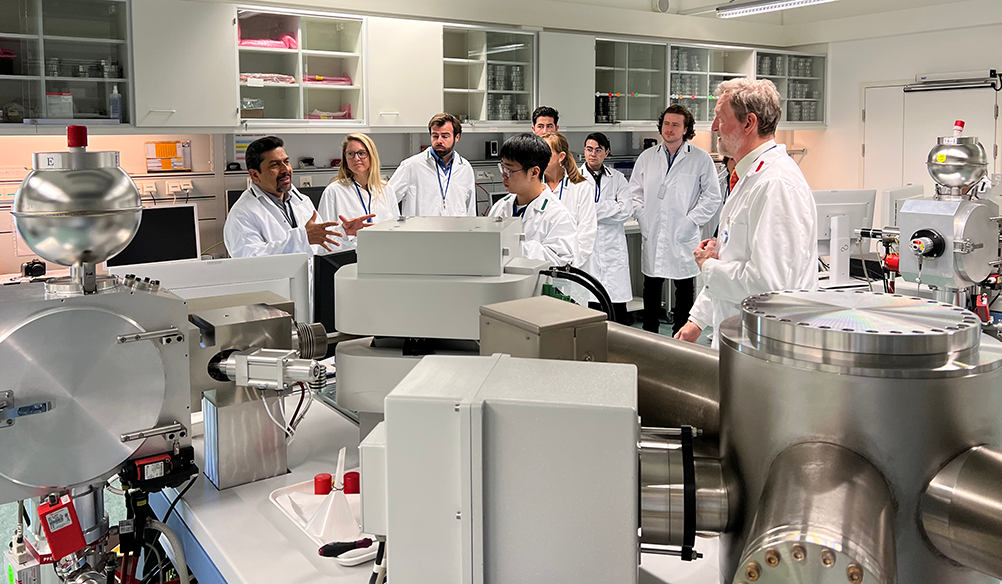
In May, the Center for Nuclear Security Science and Policy Initiatives (NSSPI) worked with Argonne National Laboratory to organize an International Nuclear Facilities Experience (INFE) in Europe for ten US graduate students working in areas related to nuclear safeguards and nonproliferation. This INFE focused on facility visits in a variety of European countries that are subject to the international safeguards regime. Claudio Gariazzo and Zachery Beauvais of Argonne led the INFE with support from NSSPI Director Sunil Chirayath and Assistant Director Kelley Ragusa. The students visited International Atomic Energy Agency (IAEA) safeguards laboratories, as well as fuel cycle facilities in Slovakia, the Czech Republic, Germany, and the Netherlands.
“The trip covered most of the steps in the fuel cycle and included opportunities to discuss safeguards in small group settings with experts at the IAEA,” Texas A&M student Billy Schmidt explained. “I cannot overstate the benefit of cementing classroom learning with real-world application.”
On the first day, after a brief orientation, the group traveled to the IAEA’s Safeguards Analytical Laboratory in Seibersdorf, Austria, where they visited the Office of the Safeguards Analytical Services and three technical support laboratories: the Nuclear Science and Instrumentation Laboratory, the Environmental Sample Laboratory, and the Nuclear Materials Laboratory. At these laboratories, the group was introduced to the IAEA’s training capacity in nuclear instrumentation and analytical techniques and learned about the IAEA’s analytical chemical capabilities for supporting verification of non-diversion of nuclear material from peaceful nuclear activities and the absence of undeclared nuclear materials.

Day two took them to the Jaslovské Bohunice Nuclear Power Plant (BNPP) near Bratislava, Slovakia. After an exterior tour of the safety features of the power plant, the participants visited the turbine hall, where they asked questions about power plant shutdowns, as well as safeguards measures. The group spent the afternoon of the second day at the IAEA Headquarters in Vienna, Austria, where they visited the Unattended Monitoring Systems Laboratory, the Nondestructive Assay Laboratory, and the Incident and Emergency Center.

The group then traveled to Prague in the Czech Republic. There they visited the Museum of Communism and toured a Cold-War-era nuclear bunker. In the nearby suburb of Rez, they visited the Czech Research Centre Rez (CVR), which houses two nuclear research reactors. Stationed reactor operators and safeguards practitioners at CVR explained the basic operations of the reactors as well as inspection activities by the IAEA, EURATOM, and the domestic regulator.
From there, the group traveled to the Netherlands from where they first visited the Framatome Advanced Nuclear Fuels (ANF) fuel fabrication facility in Lingen, Germany. At the ANF, they were able to see the fuel fabrication processes and discuss both IAEA and EURATOM safeguards with the practitioners. The final day was spent in Almelo, Netherlands between the URENCO-Netherlands uranium enrichment facility and the neighboring Enrichment Technology Company (ETC) manufacturing facility. At URENCO, the safeguards manager outlined the safeguards measures applied at the facility, which includes areas for storage, processing, and waste. ETC supplies centrifuges for URENCO, and there participants were able to understand the perspective of a non-nuclear material site impacted by the international safeguards regime.

“The INFE was an unforgettable experience that showed me how concepts I’ve learned in the classroom and through my research are actually put into action, said Texas A&M student Thomas DeGuire. Fellow Texas A&M student Danielle South echoed his assessment. “It was incredible to tour facilities and see processes that I had only ever seen on my professor’s lecture slides,” she said. “It was rewarding to connect that classroom knowledge to what was in front of me and learn even more.”
For Beauvais, the experience was invaluable to his growth as a safeguards professional and his practical understanding of safeguards implementation. “There is no substitute for setting foot in a nuclear facility,” he explained. “You can read papers and reports all day, every day, and you will still miss insights that you get immediately from performing a facility walkdown. The INFE gave me the opportunity to see IAEA-safeguarded operations, first hand, and demystify the safeguards implementation process in a manner that would not have been possible without traveling to the facilities.”